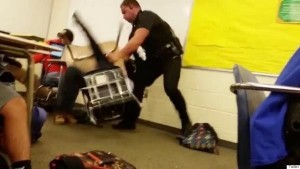After Spring Valley: Making Schools Safe and Supportive
Resource type: News
Tasha Tucker, Associate Programme Executive, Racial Equity at The Atlantic Philanthropies. |

As a native of South Carolina, I watched with complete horror and sadness the viral video of a young black girl at Spring Valley High School thrown from her desk by a police officer. This shocking display of force and aggression does not belong in a classroom, where students should be supported and nurtured, and, at the very least, safe from harm. This overly-punitive atmosphere however, is common in our schools, especially in the South, where discipline policies are implemented in a way that disproportionately target students of color and school environments perpetuate exclusionary tactics. In South Carolina, for example, black students comprised 60% of suspensions and 62% of expulsions during the 2011-2012 school year, though they make up only 36% of students in the state. Nationally, black students are suspended and expelled at a rate three times greater than white students. On average, 5% of white students are suspended, compared to 16% of black students.
The result of such disproportionate discipline is that the classroom for black students—particularly black girls like the student at Spring Valley— is not a space for learning. It’s a space for punishment and anxiety. As my colleague Kavitha Mediratta noted earlier this year, our classrooms are reinforcing racial and gender stereotypes, telling black girls that they are “’loud, defiant and precocious’ and in need of ‘social correction.’” While boys receive more than two out of three suspensions, black girls are suspended at higher rates (12%) than girls of any other race or ethnicity and most boys.
Before the incident made headlines, I’d already heard of Spring Valley High School. A few of my friends went there, and I also spent time on the campus, cheering on my sister and her track team at SC State Track meets. According to the School Digger, a site that measures educational factors such as test scores and student/teacher ratio, Spring Valley is ranked 47th of all high schools in South Carolina. The racial demographics of the school African American (50.8%), White (34.1%), Hispanic (6.8%), and Asian (6.2%). To be honest, I was astonished that this incident took place in such a well-integrated environment. The incident demonstrates that even today, 61 years after Brown vs. the Board of Education that our schools have not yet grappled with the complexities of integration. It’s clear that students experience school in different ways based on their background. We know that the student attacked by the police officer is in foster care, and was described by her classmate, Niya Kenny, as someone who was alone. Niya said, “I know this girl don’t got nobody and I couldn’t believe this was happening.” Often in schools, poverty and race intersect to create academic, social and emotional barriers for students and make them vulnerable to overly punitive discipline and push out.
Our schools should reinforce the values of equity and dignity, through fair policies that teach students to respect and trust in themselves, their teachers, and their classmates. A violent and unnecessary response for willful defiance doesn’t teach respect; it teaches—and perpetuates—fear. Unfortunately, these incidents are common, and the same troubling interactions between students and police officers happen in schools across the country every day.
I felt anger and despair watching a young girl dehumanized and brutalized, in a public school meant to serve and support all students. In my time at Atlantic, I’ve been fortunate to work closely with advocates and funders tirelessly fighting to reform these unjust discipline policies—and most importantly, I’ve been proud to see students of color lead the way in bringing these issues to light and successfully campaign to change unfair rules in their schools.
We’ve recently seen many school districts positively amend their school discipline policies. These are important victories for those students, their parents, and communities. But to truly move forward as a society, we need more than just changes in discipline codes. Our national history and recent past high-profile incidents have shown us the majority of Americans unconsciously perceive African American youth as older and more culpable than they are, associating them automatically with danger and criminality. These perceptions, rooted in the nation’s history of slavery and racial segregation, continue to define the relationships among youth of color, public institutions and popular culture. We have to have real conversations about race in order to identify and illuminate the biases that help perpetuate a faulty—and flawed—system.
But talking and teaching isn’t enough. We have to create school climates that are inclusive educational and social environments for all students to learn and prosper. Addressing and confronting our own personal biases and acknowledging the role of America’s racial history are important steps that we need to take as a nation and as advocates working for change. We need to look at the foundational racial inequities that leave black girls across the country feeling neglected and undervalued where they should be most encouraged and accepted.